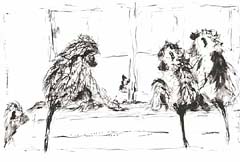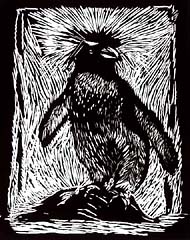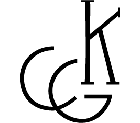|
Sloat Shaw
(Continued Here)
Sloat Shaw’s major body of work, “The
Flood Series” are oil paintings in which the artist is exploring an
imaginative landscape. These works evoke the artist’s subconscious,
interior “memories” of the earth’s transformations, after the biblical
Flood. As the earth is constantly shifting and evolving, so do her
paintings, oils on canvas, linen or paper, with stitching. They depict
an earth bathed in light and atmosphere, full of mystery and imminent
change. There is a vastness to her space, the only landmarks being the
demarcation of earth and sky, the majestic chasms of the earth, and
symbolic sticks that represent everyman, that move from the front plane
into the distance. The paintings are built up by layers of paint and
glaze, giving an added richness and depth, as well as a reverberation of
color and light that shifts as one views the image from different
angles.

|
After the Flood: Day 9 |
Her canvasses are often torn and re-stitched, a
process that relates to Shaw’s belief that our environment is not
perfect, nor is life itself, but suffers wounds and impairment, and yet,
may be repaired. The stitching reminds one of Chinese or Japanese
calligraphy, but is also meant, by the artist, “to represent the false
front with which we frame our lives, and the need to slash deeper into
the surface to reveal what we choose to ignore: our dependence upon the
earth and the interdependence of all life.”
As Sloat Shaw remarks, “We are bathed in light, flooded with water,
swirled by the wind. As modern beings we forget our relation to the
elements until the electricity goes, the phone is dead, the planes are
grounded. Paint is a way for me to express both the seen and the unseen.
It bridges the path between our world that we acknowledge, and the
hidden world that we just glimpse in our dreams. I paint the force of
the earth.”

|
Four Monkeys and A Cat |
Sloat Shaw is also a versatile and expert
printmaker. Her whimsical lithograph of
Four Monkeys and A Cat, and her dramatic linocut of a Lizard
or Penguin demonstrate her technical skills as well as her
outstanding sense of design and understanding of the power of line and
pattern. Her works on paper illustrate a love of the physical material
itself, as she delights in the texture and the often hand-worked,
pulp-pulled material of the paper itself. Using Japanese rice paper or
hand-made paper, she affords the viewer an additional dimension of
pleasure in the very materials on which her work is presented.
Sloat Shaw was awarded the 5th year degree (1990), and the Print Prize
(1990) at the School of the Museum of Fine Arts Boston and the
Grumbacher Painting Prize by Diane Waldman of the Guggenheim Museum, New
York, (1994 Silvermine). Prior to her art education, Shaw graduated with
Honors in Anthropology from Barnard College in 1972 and from Simmons
College, M.L.S. in 1975.

|
Rockhopper Penguin |
Her work is in the collection of Harvard
University’s Fogg Art Museum, the Boston Public Library, Rutgers
Zimmerli Museum, the Moscow Academy of Arts’ Suricov Institute, and the
Worcester Art Museum, Worcester, MA as well as over fifty private
collections. She has had numerous solo and group shows in Massachusetts,
Pennsylvania, Washington, D.C., Santa Fe, N.M., and New York City, as
well as in Moscow, Russia.
A respected teacher of painting and drawing, Sloat Shaw has taught at
the Wentworth Institute of Technology in Boston, MA, the Danforth
Museum, in Framingham, MA, at Lesley College, Cambridge, MA, at the
School of the Museum of Fine Arts, Boston, MA, and at the Swain School
of Design, in New Bedford, MA. She has also worked in the field of
painting conservation at The Art Conservation Resource Center of Boston,
MA.
(Continued Here) |



